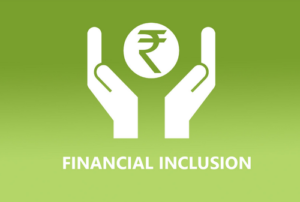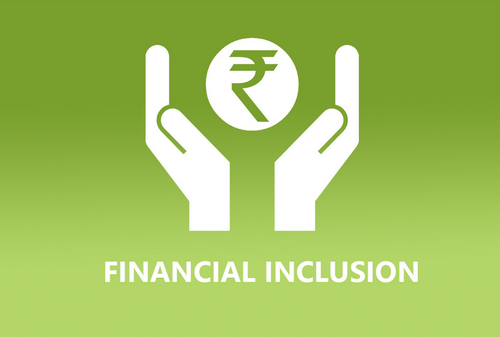 India has recently witnessed profound changes in its financial inclusion ecosystem. While financial inclusion is a point of entry to lift people out of poverty, the higher use of the full range of financial services can alone serve as a path to prosperity. Financial institutions are now indulged in a strong battle in a bid to enroll the poor as their clients, not merely for the sake of their business but also to level-up the opportunities for the poor which enables the global development winds to empower their lives. This movement to bring the unbanked into the folds of formal finance is popularly known as financial inclusion.
India has recently witnessed profound changes in its financial inclusion ecosystem. While financial inclusion is a point of entry to lift people out of poverty, the higher use of the full range of financial services can alone serve as a path to prosperity. Financial institutions are now indulged in a strong battle in a bid to enroll the poor as their clients, not merely for the sake of their business but also to level-up the opportunities for the poor which enables the global development winds to empower their lives. This movement to bring the unbanked into the folds of formal finance is popularly known as financial inclusion.
Financial inclusion, in its broader market conceptualisation is the belief that all people, including the very poor and marginal, should gain access to and be able to regularly use financial services; an idea that the World Bank promotes as part of building “inclusive economies,” it enables people to have safe place to save money, affordable and appropriately designed and affordably priced credit and trusted risk management services, a state-managed pension to gain better control over their own lives and that of their families
Enhancing financial inclusion can improve resistance to shocks, boost the productivity of business, facilitate empowerment of marginalised groups, such as women and rural residents, and help reduce poverty Life is one long risk for them as they are just a tragic event away from a financial catastrophe.
India’s flagship financial inclusion programme- Pradhan Mantri Jan Dhan Yojana (PMJDY) — launched in 2015 with a mission to provide a basic account to every adult— has significantly changed the demographics. India is now at a tipping point, with sharply narrowing gender gaps in financial access. According to the World Bank’s Global Financial Inclusion Database, or Global Findex report (2017) 80 percent Indian adults now have a bank account—27 points higher than the 53 percent estimated in Findex 2014 round. Findex 2017 estimates that 77 percent Indian women now own a bank account against respective 43 percent and 26 percent in 2014 and 2011.
The Aadhaar biometric identification system and the JAM (Jan Dhan Yojana, Aadhaar and Mobile number) Trinity is reshaping the financial landscape and has enabled India to surge to new heights. The take-off of digital financial services has largely driven this strong growth. It has also enabled one of the biggest pieces of reform ever attempted in India — direct subsidy transfers. Several state governments have adopted the default savings options by mandatorily delivering all wages to participants of government schemes and programmes through formal saving accounts.
While improved financial access is cause for celebration, the level of usage of accounts is a matter of concern. Around 48 percent of the bank accounts have seen no transactions in the last one year; the World Bank says in its Global Findex 2017 India has the world’s highest share of inactive accounts, about twice the average of 25 percent for developing economies.
Financial inclusion will remain meaningful so long as it does not end with just opening accounts. The customer must make the account his financial diary and conduct transactions to build a financial history. Or else all these accounts would remain a drag on financial institutions. Being able to have access to a transaction account is a first step toward broader financial inclusion. A transaction account then acts as a means of fulfilling these needs. Further, by becoming account holders, people are more likely to utilise other financial services like credit, investment, and insurance, which can improve the overall quality of their lives. Operating an account or using credit can also deepen consumers’ financial skills. Thus the mantra for financial inclusion should be accessed counts, but usage matters.
Accounts should basically serve as stepping stones to savings or credit. If there is little forward movement in them the entire efforts are a waste. What needs to be done is getting the customers increasing the frequency of transactions, slowly getting into the habit of saving, moving further to using formal channels for the remittance of money and then finally using them for niche products like insurance and pension. The state diktats which foist targets for opening accounts are big eyewash.
As part of government fiats, banks are forced to meet humongous targets for opening accounts to bring the unbanked population into the fold of the financial system. There is always promise that they would become a source of revenue. However, when many of them remain dormant (accounts without any transactions) and inevitably become an economic deadweight. The banks cannot afford to lose money servicing them. Services are sustainable so long as intuitions can cover the cost of their delivery. There has to be a business case for every financial service to remain sustainable. Banks have to perforce levy penalties and ultimately shut these accounts; sending them out of the financial system to where they had come from, the unbanked. Thus, a counter-revolution set in.
In the end, customers are back to where they began their financial journey. Such poorly thought out policies and programs demoralise all the actors in the ecosystem-the customers, bankers, economic observers, media, academics and the NGOs working for the financial empowerment of ordinary citizens. Moreover, it dissipates the enthusiasm of those who propel the entire effort. Finally, it reinforces the prevailing myth, that the banks are anti-poor. We must all understand the limits of the financial inclusion revolution, and we must make sure it doesn’t turn into a rough and tumble gold rush that ultimately hurts consumers and financial institutions alike. It is true that banks must be cognizant of the social dimension of financial incusing but sourcing accounts and processing them involves time and costs which pinches the revenues.
Financial services should be provided on the simple principle of a physician: diagnose the ailment and prescribe the appropriate medicine. we must know what customers need, and then suggest the products that would help them. Lack of a proper understanding can lead to a person borrowing money while all that she needs may be an insurance product or a savings account. This can set off a vicious cycle of indebtedness
In his book The Paradox Of Choice, sociology professor Barry Schwartz talks about how excessive choice contributes to consumer misery. Too many similar-looking options actually confuse consumers making them adopt the status quo to rather than taking any proactive decision. Every financial product has a cost embedded into it and we require some insight to unravel the costs and understand the risk post-cost return.
Today both financial and non-financial markets are flooded with agents hawking a bewildering array of products with a highly aggressive sales pitch. These are not backed by cutting edge consumer protection systems. Innovators are highly impatient with regulation and oversight but they must understand that lessons of the past cannot be ignored. Far too many lives have been ruined in the name of innovation and entrepreneurism.
The challenge of financial inclusion is to understand what is best about all the different ways of reaching underserved customers. It is about understanding what works and building on it. The rapid spread of mobile phones is the game changer that can make the economic benefits of digital finance possible. Fortunately, mobile phone penetration is growing far more quickly than access to financial services.
Views expressed in this article are a personal opinion of Moin Qazi, Member of NITI Aayog’s National Committee on Financial Literacy and Inclusion for Women.
Elets The Banking and Finance Post Magazine has carved out a niche for itself in the crowded market with exclusive & unique content. Get in-depth insights on trend-setting innovations & transformation in the BFSI sector. Best offers for Print + Digital issues! Subscribe here➔ www.eletsonline.com/subscription/





















